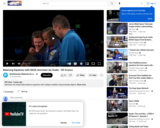
Astronaut Joe Acaba helps balance equations with multiple variables using everyday objects.
- Subject:
- Mathematics
- Material Type:
- Activity/Lab
- Provider:
- National Air and Space Museum
- Author:
- National Air and Space Museum
- Date Added:
- 09/02/2022

Astronaut Joe Acaba helps balance equations with multiple variables using everyday objects.
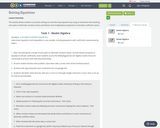
This activity allows students to practice solving one and two step equations by using an interactive tool teaching zero pairs to eliminate constant values and division and mulitplication properties to eliminate coefficient values.
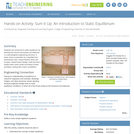
Students are introduced to static equilibrium by learning how forces and torques are balanced in a well-designed engineering structure. A tower crane is presented as a simplified two-dimensional case. Using Popsicle sticks and hot glue, student teams design, build and test a simple tower crane model according to these principles, ending with a team competition.
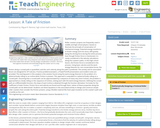
Roller coasters projects are frequently used in middle and high school physics classes to illustrate the principle of conservation of mechanical energy. Potential energy transforms to kinetic energy and vice versa, with gravity being the driving force during the entire process. Even though friction force is mentioned, it is rarely considered in the velocity calculations along the coasters’ paths. In this high school lesson, the friction force is considered in the process. Using basic calculus and the work-energy theorem for non-conservative forces, the friction along a curved path is quantified, and the cart’s velocity along this path is predicted. This activity and its associated lesson are designed for AP Calculus. Practice problems/answers, a PowerPoint® presentation and student notes are provided.
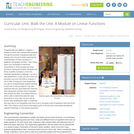
Prepared with pre-algebra or algebra 1 classes in mind, this module leads students through the process of graphing data and finding a line of best fit while exploring the characteristics of linear equations in algebraic and graphic formats. Then, these topics are connected to real-world experiences in which people use linear functions. During the module, students use these scientific concepts to solve the following hypothetical challenge: You are a new researcher in a lab, and your boss has just given you your first task to analyze a set of data. It being your first assignment, you ask an undergraduate student working in your lab to help you figure it out. She responds that you must determine what the data represents and then find an equation that models the data. You believe that you will be able to determine what the data represents on your own, but you ask for further help modeling the data. In response, she says she is not completely sure how to do it, but gives a list of equations that may fit the data. This module is built around the legacy cycle, a format that incorporates educational research feindings on how people best learn.
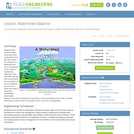
Students learn about the water cycle and its key components. First, they learn about the concept of a watershed and why it is important in the context of engineering hydrology. Then they learn how we can use the theory of conservation of mass to estimate the amount of water that enters a watershed (precipitation, groundwater flowing in) and exits a watershed (evaporation, runoff, groundwater out). Finally, students learn about runoff and how we visualize runoff in the form of hydrographs.
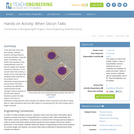
In the first half of this two-part activity, students practice solving problems involving refraction using the index of refraction and Snell's law equations; they mathematically solve for precise angles and speeds caused by refraction. In the second half of the activity, a hands-on lab, they apply the analytical skills required by the problem set to reflectance measurements of porous silicon thin films, including how reflectance measurements would change if various aspects of the film were altered. Students predict the data output in the form of reflectance measurements when samples are altered, which connects to the idea of being able to make predictions about the data output of a biosensing thin film that couples with a target molecule.